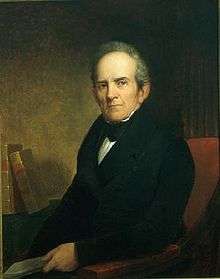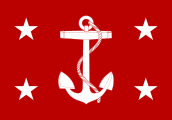Smith Thompson
| Smith Thompson | |
|---|---|
 | |
| Associate Justice of the Supreme Court of the United States | |
|
In office September 1, 1823 – December 18, 1843 | |
| Nominated by | James Monroe |
| Preceded by | Henry Livingston |
| Succeeded by | Samuel Nelson |
| United States Secretary of the Navy | |
|
In office January 1, 1819 – August 31, 1823 | |
| President | James Monroe |
| Preceded by | Benjamin Crowninshield |
| Succeeded by | Samuel Southard |
| Personal details | |
| Born |
January 17, 1768 Amenia, New York, British America |
| Died |
December 18, 1843 (aged 75) Poughkeepsie, New York, U.S. |
| Political party |
Democratic-Republican (Before 1825) National Republican (1825–1833) |
| Spouse(s) |
Sarah Livingston Eliza Livingston |
| Alma mater | Princeton University |
| Religion | Presbyterianism |
Smith Thompson (January 17, 1768 – December 18, 1843) was a United States Secretary of the Navy from 1819 to 1823, and a United States Supreme Court Associate Justice from 1823 until his death in 1843.
Early life
Born in Amenia, New York,[1] Thompson graduated from Princeton University (then known as the College of New Jersey) in 1788, taught for a short period thereafter, then studied law under James Kent and subsequently set up a law practice.[2] He practiced in Troy, New York from 1792 to 1793, and in Poughkeepsie, New York from 1793 to 1802.[1]
Politics And law
Smith Thompson was elected to the New York State Assembly in 1800, and attended the New York Constitutional Convention of 1801.[1] He was appointed to the New York State Supreme Court in 1802, serving as Associate Justice from 1802 to 1814, and Chief Justice from 1814 to 1818.[1] His wife Susanna was a member of the Livingston family.
He was appointed the 6th Secretary of the Navy by U.S. President James Monroe in 1819, and in 1823-1824, he campaigned for the Democratic-Republican Party presidential nomination for the 1824 U.S. presidential election from which he would withdraw when outcompeted by other candidates. Thompson only reluctantly accepted his appointment to the United States Supreme Court.[3] Thompson received a recess appointment from President James Monroe on September 1, 1823, to a seat vacated by Henry Brockholst Livingston.[1] Formally nominated on December 5, 1823, Thompson was confirmed by the United States Senate on December 9, 1823, and received his commission the same day.[1]
He did not give up his political ambitions there, and took the — now considered unusual, but then quite common — step of running for political office from the bench; however, his 1828 bid for Governor of New York was unsuccessful, unlike the example of Chief Justice John Jay, who had been elected governor in 1795. Thereafter he mostly exited political life, and on the court was a staunch opponent of Chief Justice John Marshall.[4]
Legacy
In May 1816, Smith Thompson was a founding vice president of the American Bible Society and provided a copy to every officer and enlisted man in the Navy while he was Secretary of the Navy.
In 1919, the USS Smith Thompson (DD-212) was named in honor of him on the occasion of the 100th Anniversary of Smith Thompson becoming the Secretary of the Navy.
See also
- List of Justices of the Supreme Court of the United States
- List of U.S. Supreme Court Justices by time in office
- United States Supreme Court cases during the Marshall Court
- United States Supreme Court cases during the Taney Court
References
- 1 2 3 4 5 6 Smith Thompson at the Biographical Directory of Federal Judges, a public domain publication of the Federal Judicial Center.
- ↑ Tomlins, Christopher, ed. (2005). The United States Supreme Court: The Pursuit of Justice (Houghton Mifflin), p. 522. ISBN 0-618-32969-2.
- ↑ Smith, Jean Edward (1998). John Marshall: Definer of a Nation (Macmillan), p. 470.
- ↑ Tomlins (2005), p. 522.
Further reading
- Abraham, Henry J. (1992). Justices and Presidents: A Political History of Appointments to the Supreme Court (3rd ed.). New York: Oxford University Press. ISBN 0-19-506557-3.
- Cushman, Clare (2001). The Supreme Court Justices: Illustrated Biographies, 1789–1995 (2nd ed.). (Supreme Court Historical Society, Congressional Quarterly Books). ISBN 1-56802-126-7.
- Flanders, Henry. The Lives and Times of the Chief Justices of the United States Supreme Court. Philadelphia: J. B. Lippincott & Co., 1874 at Google Books.
- Frank, John P. (1995). Friedman, Leon; Israel, Fred L., eds. The Justices of the United States Supreme Court: Their Lives and Major Opinions. Chelsea House Publishers. ISBN 0-7910-1377-4.
- Hall, Kermit L., ed. (1992). The Oxford Companion to the Supreme Court of the United States. New York: Oxford University Press. ISBN 0-19-505835-6.
- Martin, Fenton S.; Goehlert, Robert U. (1990). The U.S. Supreme Court: A Bibliography. Washington, D.C.: Congressional Quarterly Books. ISBN 0-87187-554-3.
- Urofsky, Melvin I. (1994). The Supreme Court Justices: A Biographical Dictionary. New York: Garland Publishing. p. 590. ISBN 0-8153-1176-1.
- White, G. Edward. The Marshall Court & Cultural Change, 1815-35. Published in an abridged edition, 1991.
External links
| Political offices | ||
|---|---|---|
| Preceded by Benjamin Crowninshield |
United States Secretary of the Navy 1819–1823 |
Succeeded by Samuel Southard |
| Legal offices | ||
| Preceded by Henry Livingston |
Associate Justice of the Supreme Court of the United States 1823–1843 |
Succeeded by Samuel Nelson |
| | |||||||||||||||||||||||||||
|---|---|---|---|---|---|---|---|---|---|---|---|---|---|---|---|---|---|---|---|---|---|---|---|---|---|---|---|
|
 | ||||||||||||||||||||||||||



